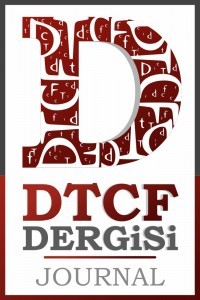JEOPATOLOJİ VE HİSTOPATOLOJİ: TOM STOPPARD'IN LEOPOLDSTADT OYUNUNDA MEKÂN, TARİH VE SÜRGÜNÜN TEATRALLEŞTİRİLMESİ
Zamanının en etkileyici ve geniş kapsamlı düşünür ve oyun yazarlarından biri olan Tom Stoppard, Wyndham's Theatre'da sahnelenen Leopoldstadt oyununu (son oyunu 2020) kaleme almıştır. Stoppard, Leopoldstadt'taki Çek atalarını daha fazla araştırmış ve Hermann Merz'in Viyana'daki yüksek sınıf Yahudi ailesini betimleyerek kendi Yahudi ailesini ve köklerini tasvir etmiştir. Oyun şüphesiz Stoppard'ın kendi kimliğinin birincil incelemesi olsa da ve kapsamlı bir Avrupa tarihini tasvir etmektedir. Stoppard'ın oyunu neredeyse yüz yılı kapsamakta ve kademeli olarak ortadan kaybolma, çözülme, sürgün ve evsizliğin anlatısını ifade etmektedir. Histopathology (tarihyazımı patolojisi/kimlik krizlerinin özellikleri) ve Una Chaudhuri'nin geopathology kuramına odaklanan makale, Stoppard'ın Leopoldstadt oyununu incelemeyi amaçlamakta ve bu nedenle oyunun okumasına farklı bir bakış açısı sunmaktadır. Hem geopathology hem de histopathology’nin tıbbi tanımları vardır. Chaudhuri'nin geopathology terimini farklı bir bağlamda kullanması gibi, amacım da histopathology teriminin etnisite, kayıp, katliam, sürgün, psikolojik rahatsızlıklar ve tarihsel bağlamda kimlik krizinin özellikleri gibi kullanımlarını genişletmektir. Chaudhuri, kimlik krizleri ve korkunç hatıraların yol açtığı kederi karakterize etmek için ‘geopathology’ ve ‘geopathic’ bozukluklar terimlerini yeniden kullanmaktadır. Farklı coğrafyalar, etnik köken, ulus ve dil ile tanımlanmaktadır. Kültürel ve ulusal kimlikler sıklıkla belirli bölgelere yönelik oluşturulur veya bu bölgelere atfedilir. Una Chaudhuri, eserinde ‘nerede?’ kavramını ‘Coğrafyasız nerede yaşıyorsun?’ kavramına dönüştüren “bir yerin kurbanı” ilkesini tartışmaktadır. Oyun ilerledikçe aile üyelerinin sayısı azalmakta ve aile ortamında evsiz yurtsuz kalma durumu giderek artmaya başlamaktadır. Bu bağlamda, bu makale aynı zamanda Stoppard'ın Leopoldstadt'taki sürgün coğrafyasını nasıl bir köksüzlük ve soykırım sembolü olarak farklı tarihsel dönemler bağlamında tasvir ettiğini de anlatmaktadır.
Anahtar Kelimeler:
geopathology, Leopoldstadt, Tom Stoppard, histopathology
GEOPATHOLOGY AND HISTOPATHOLOGY: THEATRICALISING SPACE, HISTORY AND EXILE IN TOM STOPPARD'S LEOPOLDSTADT
Tom Stoppard, one of the most fascinating and far-reaching thinkers and playwrights of his time, wrote Leopoldstadt (his last play, 2020) which was staged at Wyndham’s Theatre. Stoppard delved more into his Czech ancestors in Leopoldstadt and portrayed his Jewish family and roots, depicting Hermann Merz’s high class Jewish family in Vienna. While the play is undoubtedly a primary examination of Stoppard's own identification, and portrays a comprehensive history of Europe. Stoppard's play covers nearly a hundred of years and states the narrative of gradual disappearance, dissolution, exile, and homelessness. Focusing on ‘histopathology’ (pathology of historiography/characteristics of identity crises) and Una Chaudhuri’s term ‘Geopathology’, the paper aims at examining Stoppard's play Leopoldstadt and hence provides a different viewpoint on the play's reading. Both geopathology and histopathology have medical definition. Like Chaudhuri’s usage the term geopathology with a different context, my objective is to widen the usage of histopathology as ethnicity, loss, massacre, exile, psychological disorders and characteristics of identity crises in historical context. Chaudhuri repurposes the terms ‘geopathology’ and ‘geopathic disorders’ to characterize the grief brought on by identity crises and horrific memories. Different geographies are defined by ethnicity, nation, and language. Cultural and national identities are frequently created or attributed to certain regions. In her work, Una Chaudhuri discusses the principle “a victimage of location” which transforms the term where one is? into where do you live as if without geography?. The number of family members diminishes as the play goes, and the situation of being homelessness begins to rise in the family atmosphere. Within this context, this paper also describes how Stoppard portrays the geography of exile in Leopoldstadt as a symbol of rootlessness and holocaust within the context of different historical periods
Keywords:
Geopathology, leopoldstadt, tom stoppard, histopathology,
___
- Apter, L. E. (2008). Disorderly Decolonization: the White Paper of 1939 and the End of British Rule in Palestine. Ph.D. Thesis, The University of Texas.
- Yayın Aralığı: Yılda 2 Sayı
- Başlangıç: 1942
- Yayıncı: Ankara Üniversitesi
Sayıdaki Diğer Makaleler
Meltem DÜZGÜN, Banu CİNGÖZ-ULU, Gülden SAYILAN
PUGAÇOV İSYANI’ NIN TEMATİK İZDÜŞÜMÜ: YÜZBAŞININ KIZI
YAPILANDIRILMIŞ GÖMÜLÜ TEORİ YAKLAŞIMI İLE KÜLTÜREL COĞRAFYA ÖĞRETİMİ
ESKİ MEZOPOTAMYA’DA MATEMATİK, GENEL BİR DEĞERLENDİRME
TÜRKÇE BOYUT SIFATLARININ ANLAMSAL GÖRÜNÜMLERI: “BÜYÜK” VE “KÜÇÜK”
SAMİM KOCAGÖZ'ÜN ONBİNLERİN DÖNÜŞÜ ROMANINDA SOSYALİST ENTELEKTÜEL MESELESİ
